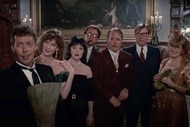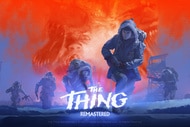Create a free profile to get unlimited access to exclusive videos, sweepstakes, and more!
‘Plumber Bros vs. Hedgehog’: Inside the console wars of 'The Toys That Built America' season finale
"If Super Mario Bros. were an airplane, then Sonic The Hedgehog would have been the Space Shuttle."

Think back, if you will, to your favorite toys growing up. If we’re not talking about a cardboard box gussied up with crayons to look like a rocket ship, we’re probably talking about something that initially entered the zeitgeist because of out-of-the-box, into-the-niche design; aggressive, ubiquitous marketing; and a whole lot of resiliency. With so much competition out there, it’s pretty much the only way to get ahead. It also takes quite a bit of luck.
Perhaps nowhere is that more apparent than in this Sunday’s Season 2 finale of The HISTORY Channel’s The Toys That Built America. The show takes an overarching look worthy of the channel it’s on, telling the many stories behind the scenes of the immense successes and devastating failures behind some of our favorite toys, and the finale, “Plumber Bros vs. Hedgehog," was no exception.
As you probably can glean from the finale’s title, the episode digs deep into the history of the rivalry between Nintendo and its flagship game, Super Mario Bros. (so popular still that we’re soon being gifted with yet another big-budget movie based upon it), and Sega and its flagship game, Sonic the Hedgehog (so popular still that it’s got an upcoming TV series based upon it).
While Atari was the first King of the Consoles, the home gaming industry was far from guaranteed after its success. The story of the rise of Nintendo, then Sega, then Sony in the marketplace is a fascinating one, that is ripe for historical dramatization and documentation, which is exactly what executive producer Keith Palmer and his team have meticulously and entertainingly done with this episode. Ahead of this Sunday’s finale, SYFY WIRE spoke with both Palmer and one of the show’s featured toy experts, Jordan Hembrough, about the episode and the show at large, to find out just what it takes to be one of the toys that built America.
RELATED: Watch: Season 2 of HISTORY's 'Unidentified' reveals a new UFO witness
Why did Atari disappear from the console scene?
Jordan Hembrough: Prior to 1983, Atari was one of the forerunners in the home video game industry, but that took a turn in the early 1980s. Due to an initial popularity of the home video market as a whole, third party manufacturers were producing games at warp speed. The overabundance of this product, combined with inferior graphics and game play, resulted in what is now known as the "video game crash" of 1983. Consumers, eager for the next big thing started spending their money on personal home computers, which were being touted as the "next level" for technology and gaming. Atari never recovered from this gaming recession and racked up losses of about $500 million.
What lessons did you learn about business, marketing and branding while creating this episode?
Keith Palmer: The number one lesson to be learned from the pioneers and innovators in the toy industry, both on the design and business sides, is perseverance. Whether it was Ralph Baer who took 15 years’ time to manipulate a TV signal into a video game, or Tom Kalinske convincing his Japanese Sega bosses to call out Nintendo’s inadequacies on his way to breaking their monopoly-like grip on the U.S. console market — they didn’t give up. They knew the value of their product and they stuck to their guns.
From a marketing standpoint, sometimes you need to get down and dirty, and Kalinske wasn’t afraid to go after Nintendo head on, calling out what he saw as Nintendo’s weaknesses. That cut-throat aggressiveness paid off. But you do have to be careful because there are times when being too aggressive can backfire like in the situation with Sony. Sony’s massive success likely led Nintendo to regret their decision to double-cross the business.
Why was Sonic the perfect answer to combat Mario’s success?
Hembrough: If Super Mario Bros. were an airplane, then Sonic The HedgeHog would have been the Space Shuttle. It was the next level of play targeting older gamers in high school who were looking for a cooler alternative. The graphics were slick and colorful, the game play was faster, and the character was one of the most innovative and memorable in arcade history, to wit: Sonic was the coolest game on the market.
How did initial gaming failure lead to Sony’s ultimate success?
Hembrough: Some of the biggest names in the video game world rejected Sony. A few would even say, potential partners double-crossed the company. In essence, Sony didn't really fail in its early attempt at the video market as much as it never got the chance to prove itself. In fact, some can argue that it was Sony's determination and quest to prove itself successful that led the company to create its own video game division and ultimately dominate the gaming market.
What commonalities did you find that the successful toys shared that the unsuccessful lacked?
Palmer:Successful toys have an addictive quality to them. Whether it’s a Rubik’s cube that you can’t put down, a Jenga game that you vow not be the one to topple again, or a video game that you just have to beat — the most successful toys are the ones that are easy to pick up and hard to put down. Some of these toys don’t have to adapt or expand because they never get old in their purest form, but others figure out how to add on to an already addictive experience. Video games are a prime example, as new games and new technologies take an '80s basement Pitfall experience and evolve it into a multi-billion-dollar, competitive gaming industry complete with spectators.
What’s the trick to making a staged business meeting exciting?
Palmer: We do our best to bring some level of action to our business meetings because dynamic visuals always help, but if you’ve connected the audience with those characters and have laid out the stakes for them along with the broader context for why that moment matters, that pure drama of two strong characters coming together can be very compelling. It’s interesting to see those characters as the precursors to who they’ve become to us today. It is also entertaining to look back at those pivotal moments and recognize if things had gone a little bit differently, the history of what we know today might not be the case.
The Toys That Built America’s Season 2 finale, “Plumber Bros vs. Hedgehog,” debuts this Sunday, Dec. 11 at 9 Eastern on The HISTORY Channel, and is available to stream the next day alongside previous episodes like “'80s Tech Toys,” “Brick by Brick,” and “Masters of the Toy Universe.”
Looking for toys in a totally different context? SYFY's Chucky is now streaming on Peacock and the SYFY App.


























